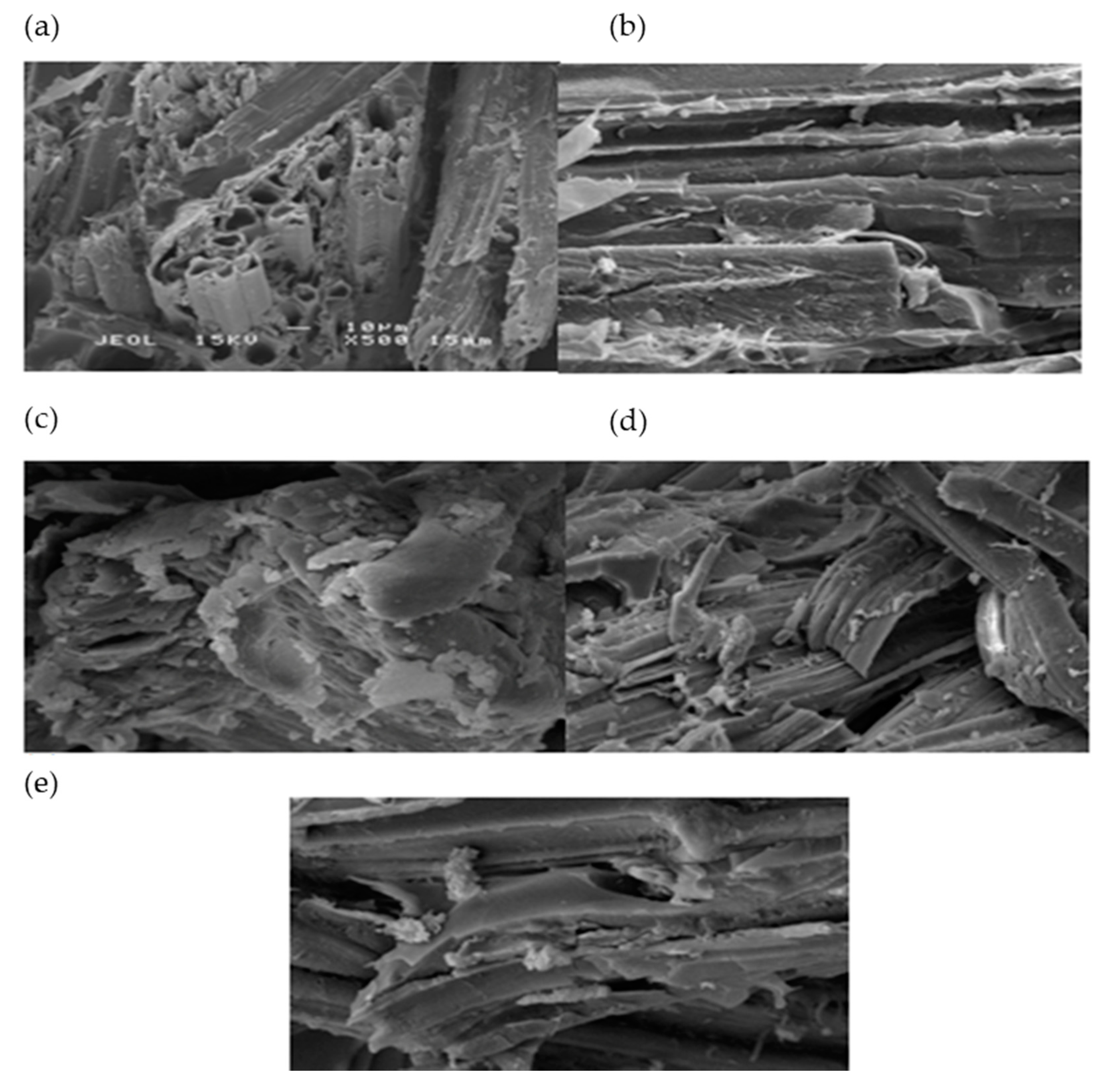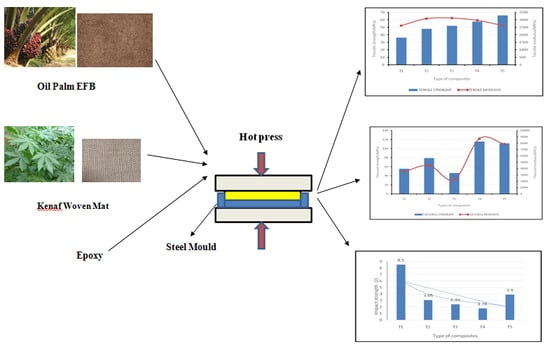1. Introduction
In recent years, the incorporation of natural fibers in polymer composites has received much attention from researchers and various industries due to their superior mechanical performance. This trend has led to the use of natural fibers for reinforcement rather than relying on synthetic fibers [
1]. Natural fibers, including kenaf, coir, oil palm, banana, kapok flax, hemp, jute, and sisal, exhibit superior mechanical properties compared to synthetic fibers. Aside from the various advantages of natural fibers such as their non-abrasive, low cost, low density, reduced energy consumption and biodegradability properties, they exhibit a few impediments such as moisture absorption and thermal degradation [
2,
3,
4]. However, different surface modifications can overcome these drawbacks [
5,
6].
In Malaysia, the overproduction of agricultural commodities such as oil palm fiber, their byproducts (empty fruit bunch (EFB), oil palm trunks and oil palm fronds) are produced in quantities in the order of millions of tons per annum [
7]. Malaysia, which is a tropical country, has hot climate and weather throughout the year, which encourages the cultivation of oil palm. Around 4.85 million hectares of oil palm industry contributes about RM 60 billion in terms of export revenues in 2010 and has grown rapidly in recent years. Malaysia has produced about 40,000–50,000 tons of crude palm oil per day and, indirectly, it has generated a vast quantity of palm biomass, which consists of two different sources, namely plantations (trunks and fond) and mills (EFB, palm kernel shell, palm oil mill effluent). The palm oil sector appears to be one of the potential energy sources due to its abundance and Malaysia is working towards the realization of the palm oil sector for producing value-added products and biochemical’s to increase the business opportunities for the palm oil industry. Empty fruit bunch, or EFB, has been widely used in the production of various products such as furniture and mattresses, in erosion control, paper production, sofa/car seats and also landscaping [
8].
The kenaf fiber, which is comparatively very cheap and commercially available in Southeast Asian countries, has been utilized as a reinforcing material in polymeric composites. Kenaf (
Hibiscus Cannabinus) is a single, straight and branchless stalk made up of core and bastfibers of 75%–60% and 25%–40%, respectively. Bast fiber is extracted from the outer layer of the kenaf plant, whereas the inner portion is used for obtaining core fiber through a retting process. Kenaf consists of cellulose (45%–57%), hemicelluloses (21.5%), lignin (8%–13%) and pectin (3%–5%) [
9]. Kenaf fiber exhibits good mechanical properties, a low density, which is nonabrasive during processing, a good specific strength and compatibility with polymers such as epoxy and phenolic resin. Kenaf fiber composites can be efficiently utilized for many light-duty applications, such as in the automotive, textile, food packaging, sports and furniture industries [
10].
Hybridizing high modulus and low modulus fiber takes advantage of their superior properties in terms of both reinforcement and results. Mirbagheri et al. [
11] found that kenaf fiber/wood flour/polypropylene hybrid composites showed improved mechanical properties after adding the maximum proportion of kenaf fibers. Atiqah et al. [
12] developed hybrid composites with glass and kenaf fabric using a sheet-molding compound process. The hybrid composites exhibited better mechanical properties compared to kenaf fiber-based composites. The mechanical and water uptake behavior of hybridized kenaf/pineapple leaf fiber-reinforced high-density polyethylene composites were studied by Aji et al. [
13] and they observed that kenaf/pineapple fiber composites showed a better impact strength and a reduction in water uptake compared to pineapple fiber composites. Jawaid et al. [
14] reported that hybrid composites consisting of oil palm/jute exhibited excellent mechanical properties compared to monolithic composites. Ewulonu and Igwe reported that increases in EFB filler content in high density polyethylene composites improved the hardness and specific gravity [
15]. Rozman et al. [
16] investigated the mechanical properties of oil palm/glass fiber hybrid composites and found that increasing the oil palm fiber content (10%, 30% and 40%) in the matrix reduced the tensile strength and enhanced the modulus. Yusoff et al. [
17] observed that the addition of 5% Vf (volume fraction of fiber) in EFB in epoxy composites can increase the tensile modulus. However, a further increase in EFB content reduced the tensile modulus of the composites. The flexural modulus of oil palm fiber/polypropylene composites attempted by Khalil et al. [
18] presented that oil palm fiber can increase the flexural modulus of pure polypropylene resin but reduces the flexural strength.
The overall performance of natural fiber-reinforced polymeric composites depends on the natural chemicals presents in the fiber, as well as physical and mechanical properties of natural fiber and polymer matrix materials [
19]. Mostly, the structural load is carried by the fiber, whereas the shape, surface and environmental resistance is carried by the matrix [
20]. The novelty of the present research work is the efficient utilization of EFB agro waste to produce a sustainable composite panel for non-load bearing applications. Moreover, the present research investigates the mechanical, morphological and physical properties of randomly oriented oil palm EFB mat/woven kenaf fabric epoxy composites.
3. Characterizations
3.1. Tensile Test
Tensile testing was carried out using a universal testing machine, (INSTRON 4201, Instron, Norwood, CO, USA) with a 100 kN capacity load cell in accordance with ASTM D 3039 standard. Five samples (120 mm × 20 mm × 5 mm) were tested with a loading rate of 5 mm/min.
3.2. Scanning Electron Microscopy (SEM)
The morphology of tensile fractured specimens of oil palm EFB, kenaf and bi-layer hybrid composites was analyzed by scanning electron microscope (Hitachi, Krefeld, Germany). The tensile fractured specimens were sputter-coated with thin layer of gold to improve the visual inspection.
3.3. Flexural Test
A flexural test was carried out by using a universal testing machine, (INSTRON 4201, Instron, Norwood, CO, USA) with a 100 kN capacity load cell according to ASTM D 790 standard. The dimensions for test samples were120 mm × 20 mm × 5 mm with a crosshead speed of 5 mm/min.
3.4. Impact Test
An impact test was performed according to ASTM D 256 standard using the Gotech GT-7045-MD model (Gotech, Taichung city, Taiwan). The Izod method was carried out using notched samples with dimensions of 70 mm × 15 mm × 5 mm. Five identical samples were tested and the results were tabulated.
3.5. Void Content
Voids in hybrid composites were determined as per ASTM-D-2734-70. The void content was calculated by using Equations (1)–(4).
where
R is the weight % of the resin in the composite,
r is the weight % of the reinforcement in the composite;
MF is the mass of the fiber,
MB is the mass of the composite,
D is the density of the resin matrix,
d is the density of the reinforcement,
Td is the theoretical density and
Md is the measured density.
3.6. Density
Density was measured by using the ASTM D1895 standard. The density of the samples was calculated by using Equation (5):
where
m is the mass of the composites, and
v is the volume of the composites.
3.7. Dimension Stability Test
Water absorption tests were carried out according to ASTM D-570 specifications. Flexural specimens were cut from the compression-molded plates and used for the measurements of water absorption and thickness swelling. After vacuum drying at 80°C for 24 h to a constant weight and a precision of 0.001 g, the weight of specimens before water immersion (
Wd) was measured, while balance and thickness were measured with a thickness gauge (
T0). The specimens were immersed in water at room temperature. Five samples of each type of composite were immersed in distilled water at room temperature. The percentage of water absorption was calculated from Equation (6) and the thickness swelling from Equation (7):
where
Wd and
Ww denote the weight of the dry material (the initial weight of materials before water immersion) and the weight of materials after water immersion, respectively. The specimens were immersed until they were saturated.
where
T0 and
Tw are the thicknesses (mm) of the sample before and after immersion, respectively.













